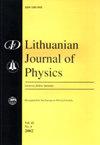热解光刻胶薄膜:电子束图案化对直流和太赫兹电导率的影响
IF 0.3
4区 物理与天体物理
Q4 PHYSICS, MULTIDISCIPLINARY
引用次数: 0
摘要
热解光刻胶薄膜(PPFs)是在不使用催化剂的情况下通过光刻胶真空退火形成的,可用于使用传统光刻技术制造石墨纳米结构。这种方法可以减少为不同应用制造导电微电极和纳米电极所需的技术步骤。然而,PPF 电极的工作频率范围仍然未知。在此,我们报告了通过电子束光刻技术在退火之前和之后制作 PPF 结构的比较研究结果,并优先采用第一种方法。通过对 PPF 传输特性的比较测量,我们发现预处理和后处理的 PPF 在直流电流和 0.2 至 1.5 太赫兹频率范围内具有相同的电导率。此外,我们还实现了 150 nm 厚 PPF 的薄层电阻低至 570 Ω/sq,与市面上的化学气相沉积(CVD)石墨烯相当。这些发现为简单、可重复和可扩展地制造适用于高达几太赫兹频率应用的石墨纳米电路、纳米谐振器和无源元件开辟了道路。本文章由计算机程序翻译,如有差异,请以英文原文为准。
Pyro lyzed photoresist thin film: effect of electron beam patterning on DC and THz conductivity
Pyrolyzed photoresist films (PPFs), which are formed via vacuum annealing of a photoresist without a catalyst, can be employed for fabrication of graphitic nanostructures by using conventional lithographic techniques. Such approach allows for reduction of technological steps required for fabrication of conductive micro- and nanoelectrodes for different applications. However, the operation frequency range of PPF electrodes is still unknown. Here, we report the results of the comparative study of PPF structures fabricated by electron beam lithography prior and after the annealing process with preference to the first approach. By performing the comparative measurements of PPF transport properties we found that both pre-and post-processed PPFs possess the same conductivities at dc-current and in the frequency range from 0.2 to 1.5 THz. Moreover, we achieved the sheet resistance of 150 nm thick PPFs as low as 570 Ω/sq, which is comparable to that of commercially available chemical vapour deposited (CVD) graphene. These findings open a path for a simple, reproducible and scalable fabrication of graphitic nanocircuits, nanoresonators and passive components suitable for applications in frequencies up to few terahertz.
求助全文
通过发布文献求助,成功后即可免费获取论文全文。
去求助
来源期刊

Lithuanian Journal of Physics
物理-物理:综合
CiteScore
0.90
自引率
16.70%
发文量
21
审稿时长
>12 weeks
期刊介绍:
The main aim of the Lithuanian Journal of Physics is to reflect the most recent advances in various fields of theoretical, experimental, and applied physics, including: mathematical and computational physics; subatomic physics; atoms and molecules; chemical physics; electrodynamics and wave processes; nonlinear and coherent optics; spectroscopy.
 求助内容:
求助内容: 应助结果提醒方式:
应助结果提醒方式:


